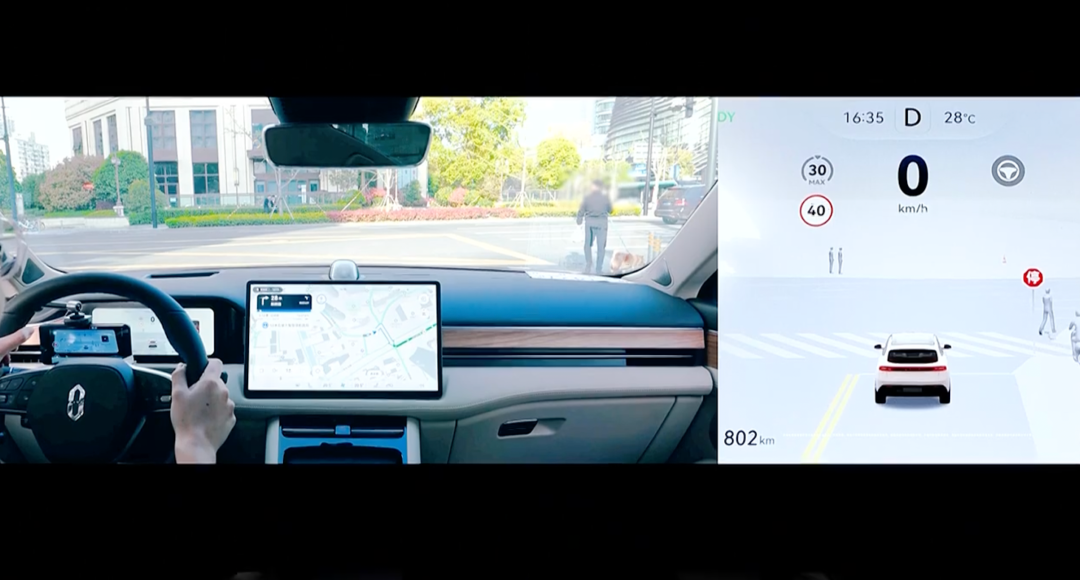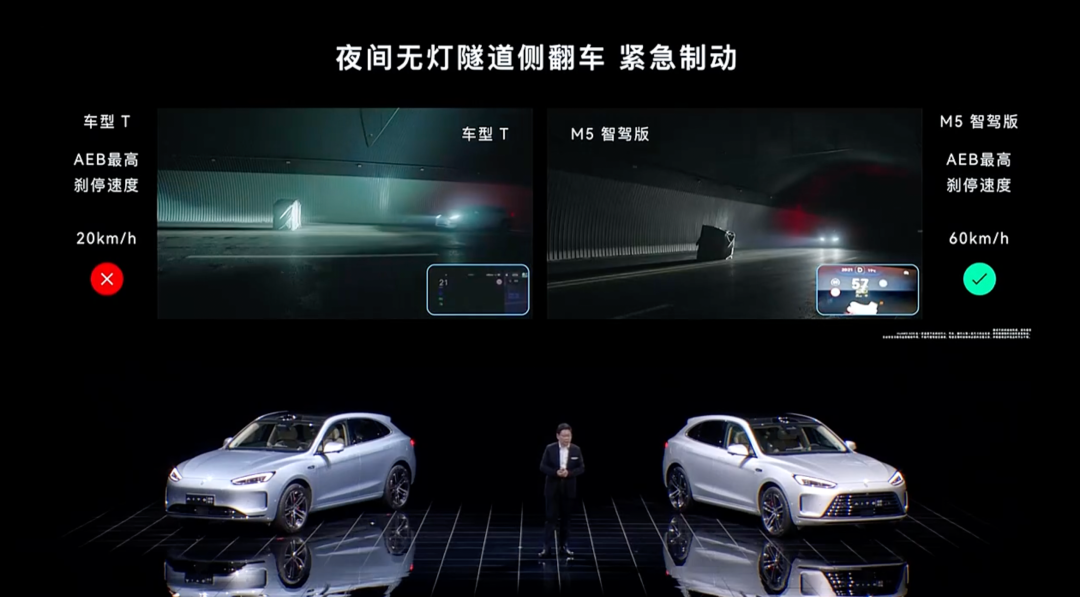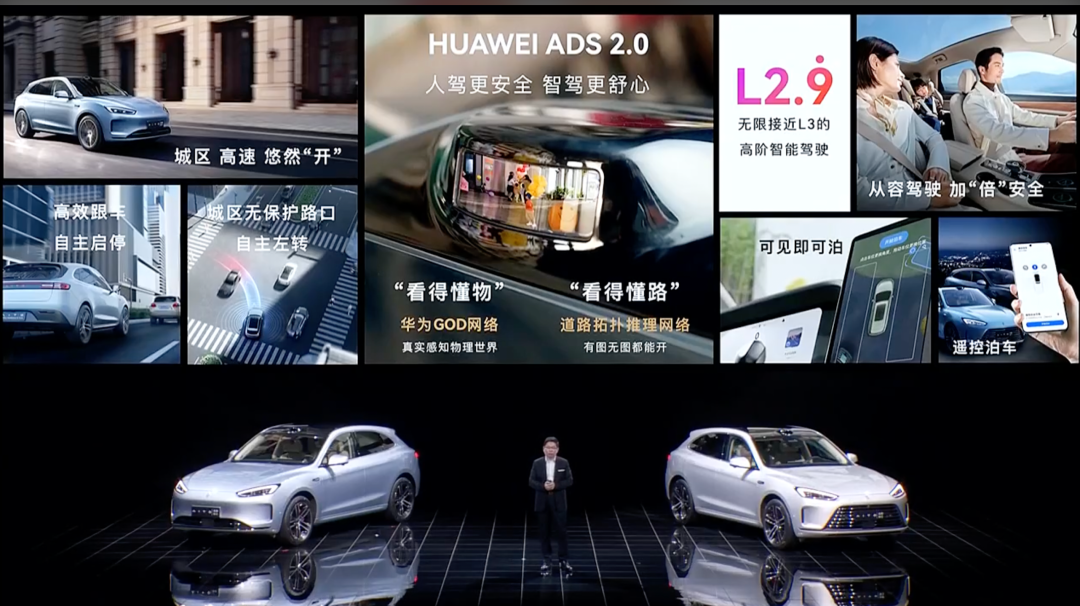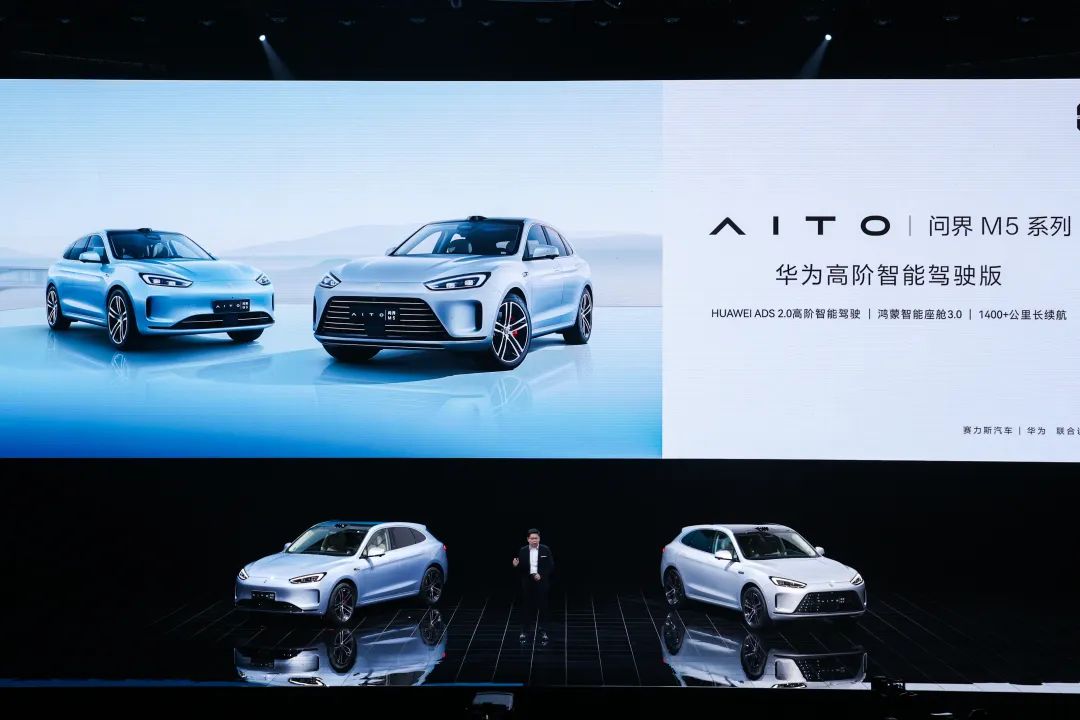Starting at 279,800 RMB – the Huawei high-end intelligent driving ADS 2.0 will finally be implemented on a mass-produced vehicle.
On April 17th, the Huawei high-end intelligent driving version of the Ask series M5 (hereinafter referred to as Ask M5 smart driving) was officially released, with a price range of 2.798 million to 3.098 million RMB.
Compared with other models of the same series previously released, the biggest highlight of the Ask M5 smart driving version’s product is that it is the first to be equipped with the Huawei high-end intelligent driving system ADS 2.0.
At the press conference, Yu Chengdong – executive director, CEO of the End BG, and CEO of the Intelligent Car Solution BU expressed his confidence in the Ask M5 smart driving version’s intelligent driving capabilities with the phrase “Intelligent Driving Ceiling”.
With close attention to the Ask M5 smart driving version, the 42 Garage also experienced the actual performance of the car in terms of intelligent driving through advance trial driving, and through exchanges with the OEM and Huawei, it gained a deeper understanding of the true strength and business considerations behind this car.
Therefore, our conclusion is that the Ask M5 Smart Driving version is Huawei’s gift to the market and users in the field of intelligent driving, after years of research and development investment and technological accumulation. But its more important significance is:
Just as the intelligent driving approach the crucial nodes, and the whole industry is promoting the landing of urban NOA. In the face of the question of “how to better mass produce and commercialize intelligent driving,” the Ask M5 smart driving version has provided a referenceable solution for the entire automotive industry.
Like a real human driver
In terms of actual intelligent driving experience, the most intuitive feeling that the Ask M5 smart driving version gives us is that it may be one of the car models closest to the experience of a human driver among the industry.
Even in some specific scenarios, it performs better than humans.
First of all, safety is the first priority for intelligent driving to exist, and in terms of safety in intelligent driving, the Ask M5 smart driving version provides us with full confidence. From specific scenes:- The lane changing strategy is extremely flexible and precise, ensuring sufficient safety distance.
- When encountering a situation where the front lane is occupied, the WENJIE M5 Intelligent Driving Edition can identify it in advance and make its own decision, adopt the method of slowing down in advance, and then pass through when the safety is confirmed.
- When encountering a slow-moving non-standard large vehicle, it can use laser radar to recognize and reduce speed for prediction — the key is that when passing the large vehicle, the car body consciously maintains a lateral distance from the large vehicle; if the large vehicle is too close to the car body and feels oppressed, it will actively make lateral avoidance.
- Compared with the current whitelist plan in the industry, it can recognize various non-standard obstacles, so it can deal with more irregular, non-standard, and untrained scenes, making driving safer.
- While driving normally in the current lane, if a suddenly opened door of a car blocking the road ahead is encountered, it can identify it accurately and make timely actions such as deceleration and detouring.
Overall, the WENJIE M5 Intelligent Driving Edition presents the reassuring safety during the use of intelligent driving.

During the communication process, the engineer responsible for the implementation of this intelligent driving solution informed us that achieving higher safety than the driving process of human drivers is actually the greatest value that current intelligent driving can provide to users.
Of course, based on safety, the intelligent driving equipped on the WENJIE M5 also embodies a judgment and operational ability similar to that of human drivers to a high degree. We’ll give a few more examples:
-
At a crossroads without left turn protection, the vehicle can accurately enter the left-most turn lane and left turn waiting area, waiting for the green light to go through; it can make accurate judgments based on the size of oncoming traffic, safely passing through the oncoming lane without sudden braking during the process.
-
The vehicle will actively give way to pedestrians on zebra crossings and non-motor vehicles on bicycle lanes. When there is no traffic signal control, it will also pass through the crowd strategically while ensuring safety.
-
The overall driving style is similar to that of experienced drivers, with a “stable” driving style. To ensure safety, it will not be particularly aggressive, nor will it be particularly conservative like novice drivers.
-
Based on the fusion perception ability, it can already recognize various non-standard obstacles and perform corresponding braking or detour operations. If cats, dogs and other animals are encountered during the driving process, the vehicle can not only see them, but also stop accurately, identify them accurately and avoid them.In terms of parking, the WENJIE M5 smart driving version has demonstrated powerful capabilities according to its official claims:
-
It can identify parking spaces and perform parking environment reconstruction based on multi-sensor fusion, supporting complex shaped parking spaces. Its parking recognition rate and success rate are very high, and its parking position selection is excellent. It can even automatically search for parking spaces outside the car with 360° surround view while parking, and display real-time available parking spaces on the dashboard.
-
It has a “cross-level memory parking” function based on learning parking lot routes. It can construct a parking lot environment and save parking spaces on its own. After the first time of autonomous parking, users can activate the assisted parking function and cruise to the target parking space for automatic parking when arriving at the parking lot, freeing the driver’s hands and feet.
In terms of the highly anticipated NCA function, the WENJIE M5 smart driving version has achieved support for high-speed NCA. More importantly, it can also achieve support for urban NCA function through subsequent OTA software upgrades. It is expected to promote the high-end intelligent driving scheme without specific maps to 15 cities nationwide in Q2 of this year, and to 45 cities in Q4.
It should be emphasized that the WENJIE M5 smart driving version’s support for urban NCA does not rely on high-precision maps. Although the entire industry is making efforts to eliminate its dependence on high-precision maps, many players have not provided specific landing plans or timetables. However, the WENJIE M5 smart driving version has already explicitly stated its plan to achieve mapless urban NCA, which is not easy.
Of course, considering that most of the users’ daily driving is in urban scenarios, the subsequent landing of urban NCA function undoubtedly brings higher value to users of the WENJIE M5 smart driving version.
We believe that based on the current test-driving experience, the WENJIE M5 smart driving version demonstrates a relatively mature level in the industry at the level of intelligent driving. However, regarding its actual capabilities in real-world scenarios, we will conduct detailed testing on mass-produced models of the M5 using 42Mark, so stay tuned.
How did the WENJIE M5 smart driving version achieve it?
Regarding the intelligent driving experience displayed during the test driving of the WENJIE M5 smart driving version, a question worth pondering is: How did the WENJIE M5 smart driving version achieve its capabilities?Let’s take a look at the sensor configuration.
According to Garage 42, the WENJIE M5 Intelligent Driving Edition uses a fusion perception system consisting of laser, millimeter-wave, machine vision, and ultrasonic technologies.

Specifically, the WENJIE M5 Intelligent Driving Edition is equipped with one top-mounted laser radar, three millimeter-wave radars, 11 high-definition cameras for lateral and rearward perception, and 12 ultrasonic radars, which can perceive dynamic and static targets (including irregular objects). The 128-line laser radar can achieve precise distance measurement, while the high-definition camera can recognize the environment, and the front-facing dual-camera has a pixel count of up to eight million.
In addition, the WENJIE M5 Intelligent Driving Edition’s millimeter-wave radar uses a new glass antenna technology, equipped with four MIMO antennas, which doubles the signal and increases it by at least 3dB compared to industry-leading levels.
Therefore, it is precisely because of the “fusion solution of laser radar and visual perception” that the WENJIE M5 Intelligent Driving Edition can withstand adverse weather and low-light conditions, cope with various complex scenarios, and achieve a high-level intelligent driving experience.

From the perspective of the sensor configuration, the WENJIE M5 Intelligent Driving Edition did not adopt the strategy of forcibly stacking sensor configurations, but sought to enhance the capabilities of specific sensors on the basis of meeting basic requirements, thus greatly improving perception abilities.
Similarly, in terms of computational power, according to Garage 42, the WENJIE M5 Intelligent Driving Edition did not adopt the approach of blindly stacking processor performance, but rather adopted a more reasonable and practical strategy based on meeting the actual computing requirements of intelligent driving.
It is worth mentioning that in addition to sensors and computational power, the true strength of the WENJIE M5 Intelligent Driving Edition’s intelligent driving system lies in algorithm optimization and software.
For example, at the perception level, in order to allow the vehicle to better perceive the physical world, in addition to the commonly used BEV (Bird’s Eye View) network for fusing perception, it has the industry’s first General Obstacle Detection (GOD) network, which can identify various obstacles beyond the white list.
Furthermore, based on the multi-sensor fusion perception system and combined with the road prediction neural network, the intelligent driving system of the 42 M5 can realize the correlation of traffic elements, the inference of road structure topology, and the matching of navigation maps with real roads, making the vehicle perception not only “see” but also “understand”.
According to the 42 Garage, Huawei’s Intelligent Driving team has also employed highly experienced drivers as teachers to continuously teach the machine learning from their driving style, thus improving the algorithm.
Of course, the reason why these algorithms can be continuously optimized is due to the construction of a sophisticated AI training cluster to build a rich scenario library. Through it, vehicles can conduct millions of kilometers of simulation tests every day to explore difficult scenarios, use massive amounts of data to achieve continuous iteration and optimization of intelligent driving algorithms and scene strategies, and make the vehicle smarter and smarter.
In the view of the 42 Garage, this is essentially the thinking of a large model.
Overall, the specific landing strategy of the 42 M5 smart driving system in terms of intelligent driving is very clear: it does not excessively emphasize the types and quantity of sensors or the computing power, but focuses on optimizing software and algorithms based on users’ actual usage scenarios and needs.
And this path also ensures that more consumers can feel the safety, convenience, and intelligent experience brought by intelligent driving itself in a more accessible price range.
Intelligent driving, landing ability is the key
For the development of intelligent driving as a whole, 2023 is a crucial year with a key node meaning.
After all, in the field of intelligent driving, the entire automotive industry has been exploring an effective path towards a wide consumer base on multiple levels such as technology, market, policies, etc. – and now, in 2023, with the NCA functions of cities and other features beginning to be integrated into mainstream production vehicles, the entire industry has seen the chance for the large-scale realization of intelligent driving.
Against this background, the release of the 42 M5 smart driving system is of multiple significance for the development of the intelligent driving industry.
 On the one hand, as the trend of intelligent driving towards mass production cars is becoming more prevailing, the QJ M5 Smart Driving Edition, which comes equipped with Huawei’s advanced intelligent driving technology, has been officially released, playing an important role as a participant and promoter in this trend. On the other hand, the QJ M5 Smart Driving Edition has brought inspiration to the industry on how to promote the large-scale implementation of intelligent driving.
On the one hand, as the trend of intelligent driving towards mass production cars is becoming more prevailing, the QJ M5 Smart Driving Edition, which comes equipped with Huawei’s advanced intelligent driving technology, has been officially released, playing an important role as a participant and promoter in this trend. On the other hand, the QJ M5 Smart Driving Edition has brought inspiration to the industry on how to promote the large-scale implementation of intelligent driving.
Currently, there are several evident trends in the entire intelligent driving industry:
- The urban intelligent assisted driving represented by NCA is constantly being implemented, which is considered as the ChatGPT moment of autonomous driving. Players such as NIO, Xiaopeng, and Ideal are all pushing for implementation within this year.
- The intelligent driving technology solution based on BEV perception + Transformer large model has become the mainstream solution being promoted by many players.
- Under the strategy of “heavy perception, light map,” major players in the intelligent driving field are emphasizing the need to break away from reliance on high-precision maps, which is also an important prerequisite for urban NCA to move towards implementation.
Obviously, the release of the QJ M5 Smart Driving Edition is a powerful affirmation of these trends.
However, it should be noted that during the process of large-scale production and implementation towards consumers, the QJ M5 Smart Driving Edition has brought some new inspiration to the industry, specifically:
- From the perspective of mass-produced cars, the method of relying on hardware such as piled up sensors and processors is no longer practical and cannot obviously achieve user value matching with hardware investment.
- What the entire industry needs to do is to continuously optimize and iterate on the software and algorithm level under the premise of meeting the demand for perception and computing power, thereby achieving better user experience.
- What is truly important in intelligent driving is to start from daily car usage scenarios of users and provide intelligent driving with high safety and in line with human intuition, which is the most crucial.
Therefore, the QJ M5 Smart Driving Edition is also reminding the entire industry that:
The value of intelligent driving for users is not about having strong parameters, but about bringing good user experience, seeking implementation that truly faces mass production and the market, and reaching users with more reasonable and user-friendly prices.
In 42 Garage’s view, the QJ M5 Smart Driving Edition is a pioneer that deeply understands and practices this industry perception.The intelligent driving team behind this product plays an indispensable role in the combination of software and hardware, especially in the algorithm software of the technical engineering capability. On the other hand, the Wanjie M5 smart driving version demonstrated deep insights into the industry, market and user needs.
It is the combination of the two that makes the Wanjie M5 smart driving version powerfully bear a smart driving solution that contains both black technology attributes and practicality. In the context where China’s smart driving industry is actively seeking large-scale landing in 2023, the Wanjie M5 smart driving version provides the best example for all players in the industry.
Looking ahead to 2023 and beyond, as the Chinese automobile industry officially enters the hot trend of large-scale production and landing of smart driving, it can be discovered that the Wanjie M5 smart driving version is a landmark product at the moment of this trend. It embodies a high balance of smart driving in three aspects: technology strength, practical experience, and market landing.
In fact, this points to a philosophical proposition of the automobile industry, which is that:
No matter how sophisticated the technology is, it must be effectively “landed” towards consumer users to truly realize its value.
From this perspective, the release of the Wanjie M5 smart driving version makes the true connotation of the “smart driving ceiling” more profound and clear. At the same time, in terms of the commercial landing dimension of smart driving, the Wanjie M5 smart driving version provides a truly referenceable leading solution for the entire Chinese automobile industry.

This article is a translation by ChatGPT of a Chinese report from 42HOW. If you have any questions about it, please email bd@42how.com.
